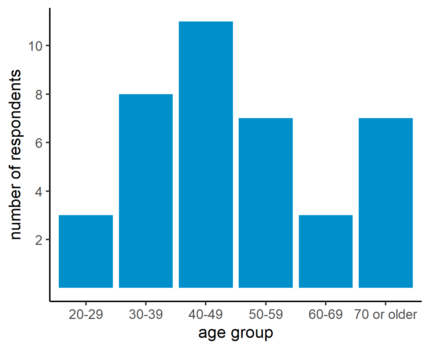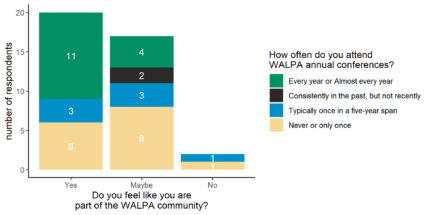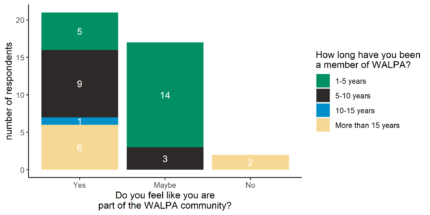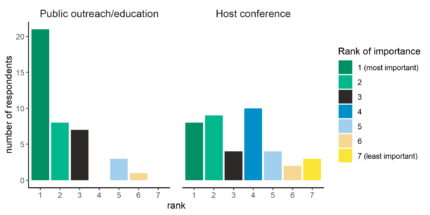Angela Strecker, Katie Ruthenberg, and Rebekah Stiling, WALPA Diversity, Equity, and Inclusion Committee
 In 2021, the WALPA Diversity, Equity, and Inclusion (DEI) Committee conducted an anonymous survey of WALPA members. The purpose of the survey was: 1) learn about member interests and engagement; and 2) examine the demographic makeup of our membership. The survey consisted of 20 questions and was open for two months. We received 40 responses out of the roughly 700 email addresses in our database to which we sent the survey. This is a response rate of 6%. The email list includes anyone who has ever been a WALPA member, so we attribute the low response rate to fewer members remaining active.
In 2021, the WALPA Diversity, Equity, and Inclusion (DEI) Committee conducted an anonymous survey of WALPA members. The purpose of the survey was: 1) learn about member interests and engagement; and 2) examine the demographic makeup of our membership. The survey consisted of 20 questions and was open for two months. We received 40 responses out of the roughly 700 email addresses in our database to which we sent the survey. This is a response rate of 6%. The email list includes anyone who has ever been a WALPA member, so we attribute the low response rate to fewer members remaining active.
Here, we highlight some key takeaways from the survey and proposed next steps.
Representation within WALPA
Representation of society as a whole is vital to the mission of WALPA. Our results found that while there was parity between members identifying as male and female (47.5 and 45%, respectively) and a relatively diverse age structure (Figure 1), the vast majority of respondents were white (85%), heterosexual (87%), and do not identify with a disability (85%). These findings mirror those in other STEM fields, as a whole, but are not representative of our society.
To increase access and retention for lake science professionals, some suggested actions include:
- Start a student/early career mentorship program;
- Develop and implement a recruitment plan focused on Tribal and Hispanic-Serving universities and colleges;
- Improve accessibility for members with mobility, sensory, or other disabilities, including at meetings and in communications.
To establish anti-racist and anti-colonial practices, some suggested actions include:
- Prepare a land acknowledgement statement for annual conferences;
- Broaden our understanding of historical connections between racism, colonialism, and the field of limnology.
Membership and Belonging in WALPA
Overall, 47.5% of members answered no or maybe to the question about whether they feel like they are part of the WALPA community. When these responses were cross-referenced against meeting attendance, there were some trends, in that members who attended every year or almost every year were more likely to feel part of the community, whereas those who had never attended or only once were more likely to say no or maybe (Figure 2).
A feeling of belonging also appears to be related to how long respondents have been members, with 16 out of 21 respondents who have been members for >5 years answering yes to a feeling of belonging, while only 5 of 19 respondents who have been members for <5 years responded yes (Figure 3).
These results suggest that WALPA can do a better job engaging its members and creating a sense of belonging, especially with students and new members.
Some suggestions include:
- Recruit a student board member to better represent student needs and interests;
- Examine how we define membership, with the goal of increasing participation among members, not necessarily the number of members;
- Target outreach more specifically to the student membership category;
- Start a student/early career mentorship program.
Focus for the Future
Of the members who completed the question, “What would you like to see WALPA focus on in the future?” approximately half indicated a desire for public outreach and education to be the top priority. Outreach and education may not necessarily mean a conference, which was a high, but not the top, priority for many respondents (Figure 4). Projects like the Western Lakes Workshop may be an example of the types of engagement/education WALPA should promote and create in the future. Findings from a recent University of Washington study on lake users may also shed light on the needs or desires of lake users and inform education around stewardship.
Suggestions include:
- Center community interests in public outreach/education initiatives;
- Support equitable access to lake recreation in outreach/education initiatives;
- Continue supporting the Western Lakes Workshop and expand it.
Annual Conference
As discussed above, the conference seems to be key to engagement with members. How do we increase participation and conference attendance? Of the 12 respondents who answered the question about barriers to attendance, most (11 of 12) had been members for fewer than 10 years, suggesting that these barriers might be particularly challenging for early career members. Barriers included the cost, timing, family considerations, and location.
Some suggestions include:
- Reduce barriers to attending, when possible. These could include reduced rates for early career members, support for childcare during the meeting, etc.
- Explore options for having hybrid meetings or alternating in-person and remote meetings. Conference attendance at the WALPA Annual Meeting in 2020–held virtually with no cost–was 163. The average registration for the prior five in-person meetings was 81. This suggests that virtual conferences can provide the same amount of participation, and even expand participation, if offered at low or no cost. Hybrid conferences would need to include networking opportunities for virtual participants to allow access to critical inclusionary networking.
- Plan conference events that center accessibility, diversity, equity, and inclusion, and explore how we–as individuals and as an organization–can encourage meaningful dialogue and actions in this sphere. For example, include accessible accommodations at conferences.
We’d love to hear what feedback you have on these issues. Please consider submitting your anonymous input here.













